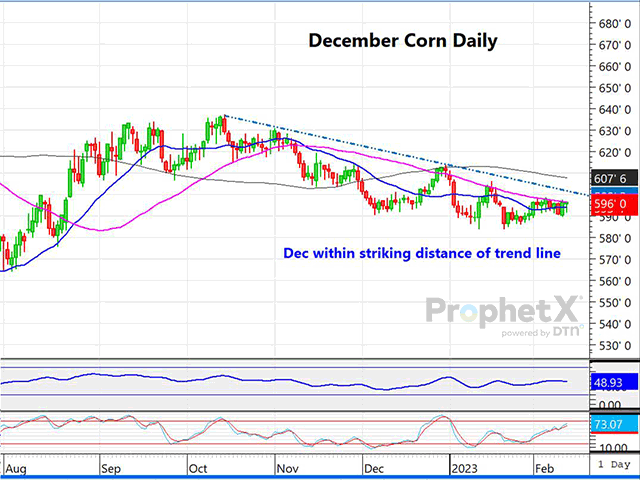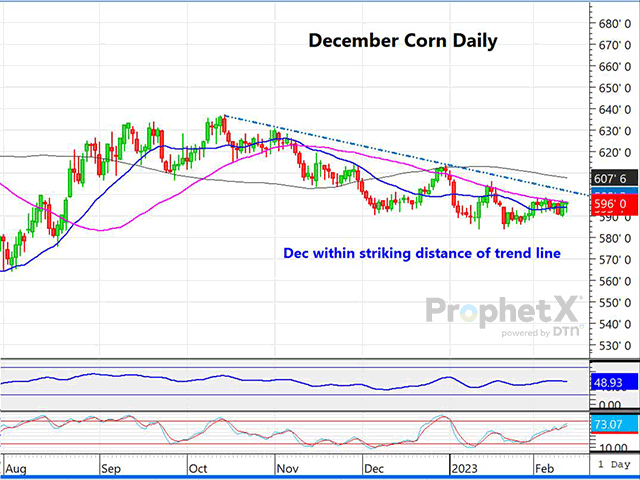Technically Speaking
December Corn Futures Nearing Trend Line, Solid Resistance Level
While obviously a sharp discount to spot March corn futures, new-crop December is within 6 to 7 cents of major down-trend resistance, with more substantial interest just above that. With solid potential for corn acres to be elevated in 2023, and with Brazil set up for a potential record-large corn crop (weather permitting), this may be an area to consider some sales of new-crop corn.
USDA, in their baseline projection, expects corn acres to rise by 3.2 million acres to 92 million. That, coupled with the expectation that, with good weather, Brazil could produce an all-time record-large corn crop on the order of 125 million metric tons (mmt) to 126 mmt should certainly be a bearish weight over the corn market. In the past year, prices have been elevated, with the spot March at about a 90-cent inverse to December, mostly influenced by Argentina's historical drought. However, U.S. corn export sales commitments remain down 41% from a year ago, and it seems likely ending stocks will be increased further.
The trend-line area of $6.00 to $6.02 is likely to be one of strong resistance, while just above that at $6.10 to $6.20 should be an area of very formidable resistance, barring a drought in Brazil.
P[L1] D[0x0] M[300x250] OOP[F] ADUNIT[] T[]
The soybean meal futures market has been a runaway train, with spot March futures scoring yet another new contract high on the Sunday night Globex. There is little doubt that soymeal strength is related to the prospect of a sharply lower Argentine bean crop. However, in the latest USDA February report, the WASDE had the loss of Argentine meal exports totally offset by Brazilian meal.
While U.S. soymeal demand remains stout with basis levels from $9 to $15 over spot futures in Illinois and Iowa, U.S. soymeal exports have seen little benefit from the Argentine woes. Also, adding some potential bearishness is my feeling that once the CFTC Commitments of Traders report returns we are likely to see an all-time new-record long by managed money funds in meal -- perhaps a warning sign for a market that is overdone.
How high can soymeal go? It is tough to stand in front of this freight train, but I think there are enough bearish factors down the road to make this market appear like a house of cards. It's only the timing of that which makes it difficult to call.
KC MARCH WHEAT FUTURES:Kansas City spot March wheat futures appear to have changed trend to up. Last week, the 20-day moving average crossed above the longer-term 50-day to the upside. That and Friday's close above the 100-day moving average are solid signs of strength. While there doesn't appear to be a lot of significant resistance to stem the upward tide, beyond the $9.30 level, a word of caution for bulls might be the fact that momentum indicators appear to be getting very overbought, suggesting a downward correction could be near. However, with the tightest U.S. wheat stocks in years, and with the potential for Russia to end the Black Sea Grain Initiative in March, KC could be poised for further gains.
**
Comments above are for educational purposes and are not meant to be specific trade recommendations. The buying and selling of grain and soybean futures involve substantial risk and are not suitable for everyone.
Dana Mantini can be reached at Dana.Mantini@DTN.com
(c) Copyright 2023 DTN, LLC. All rights reserved.








Comments
To comment, please Log In or Join our Community .